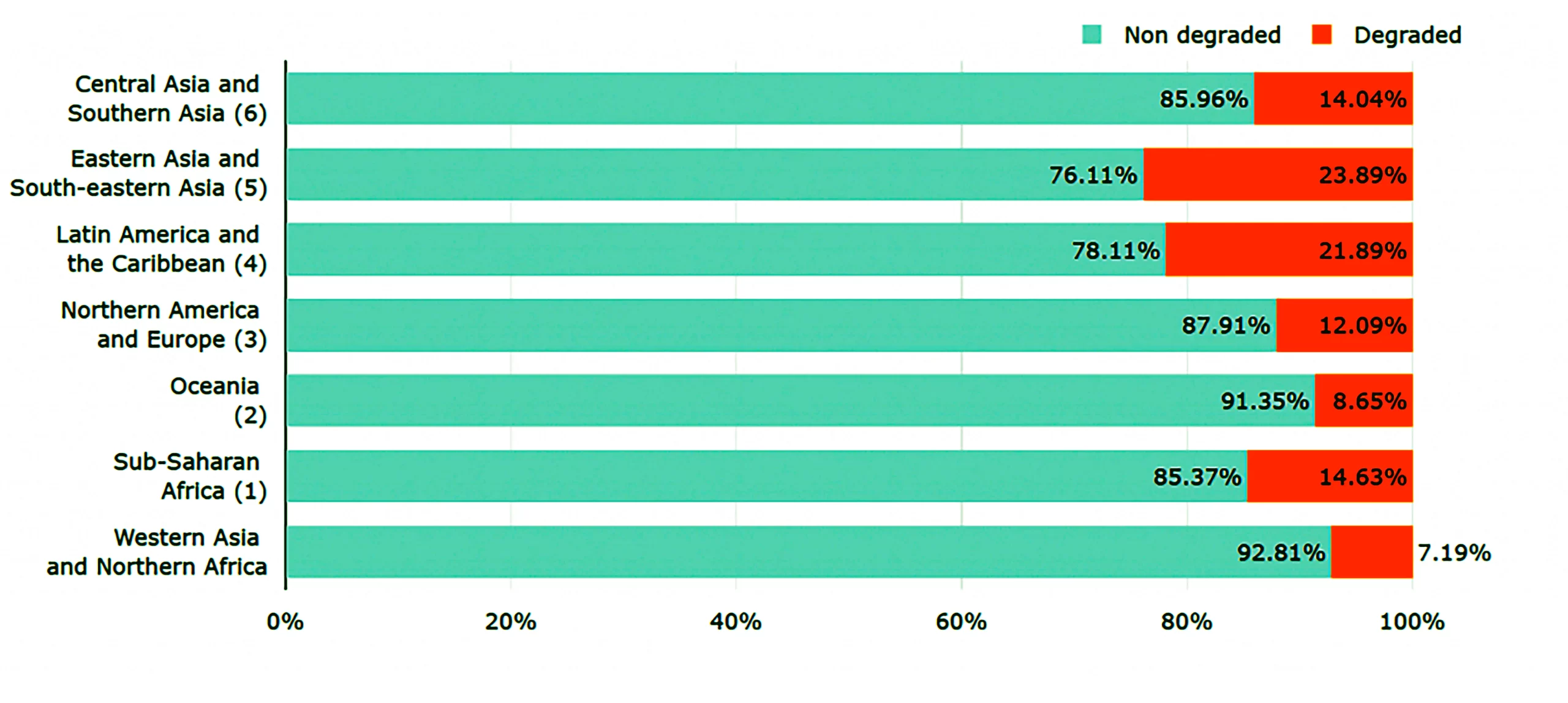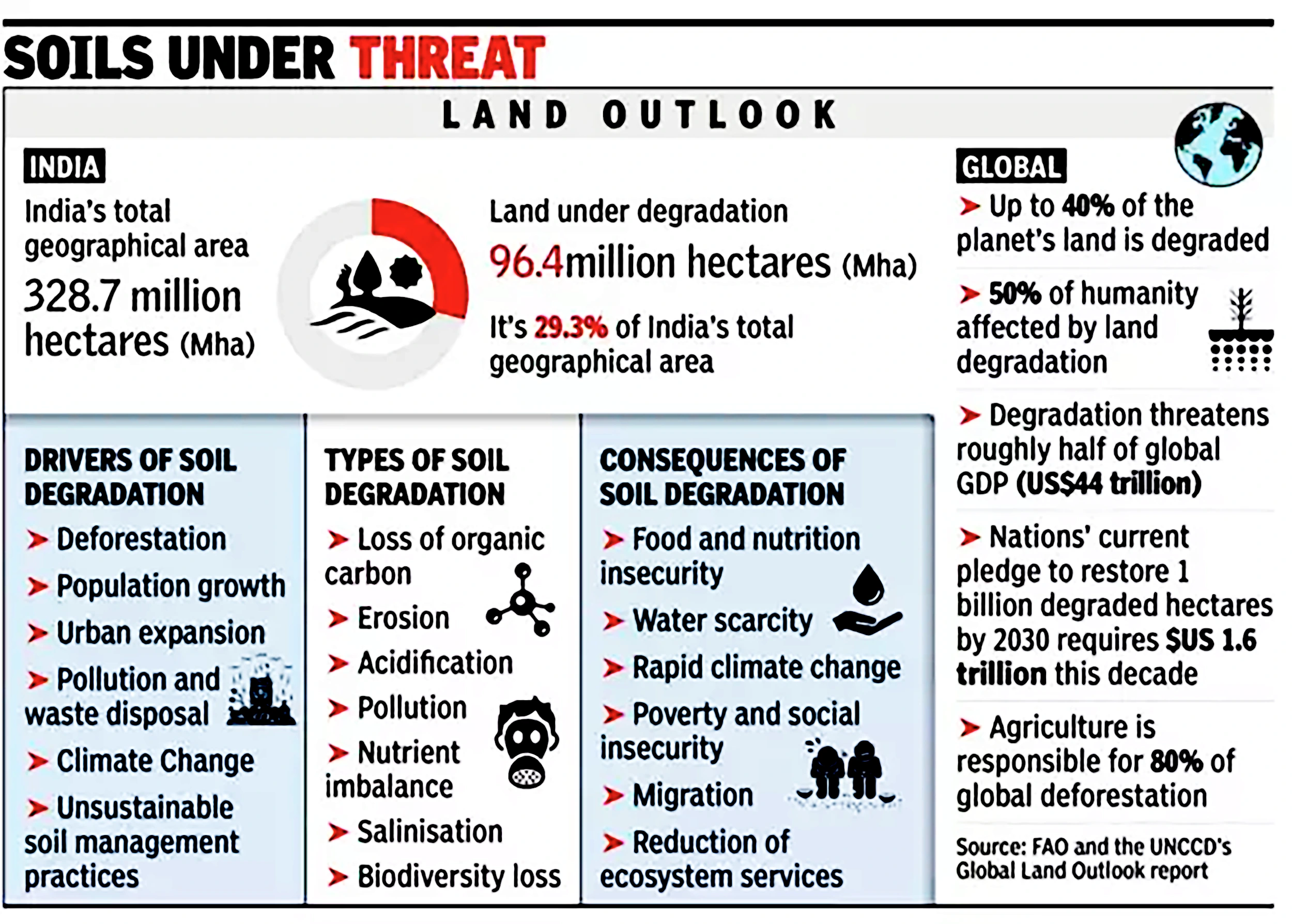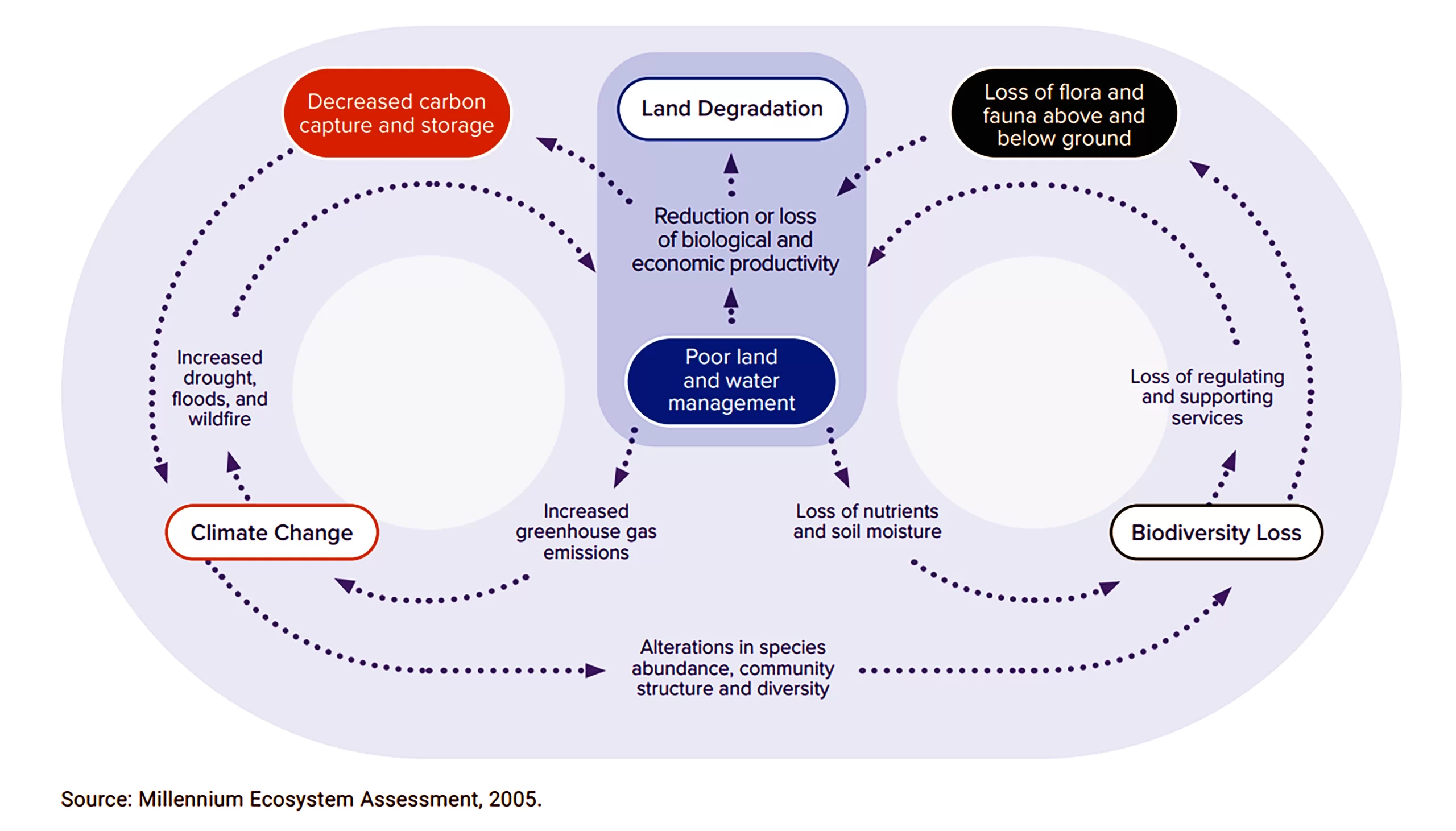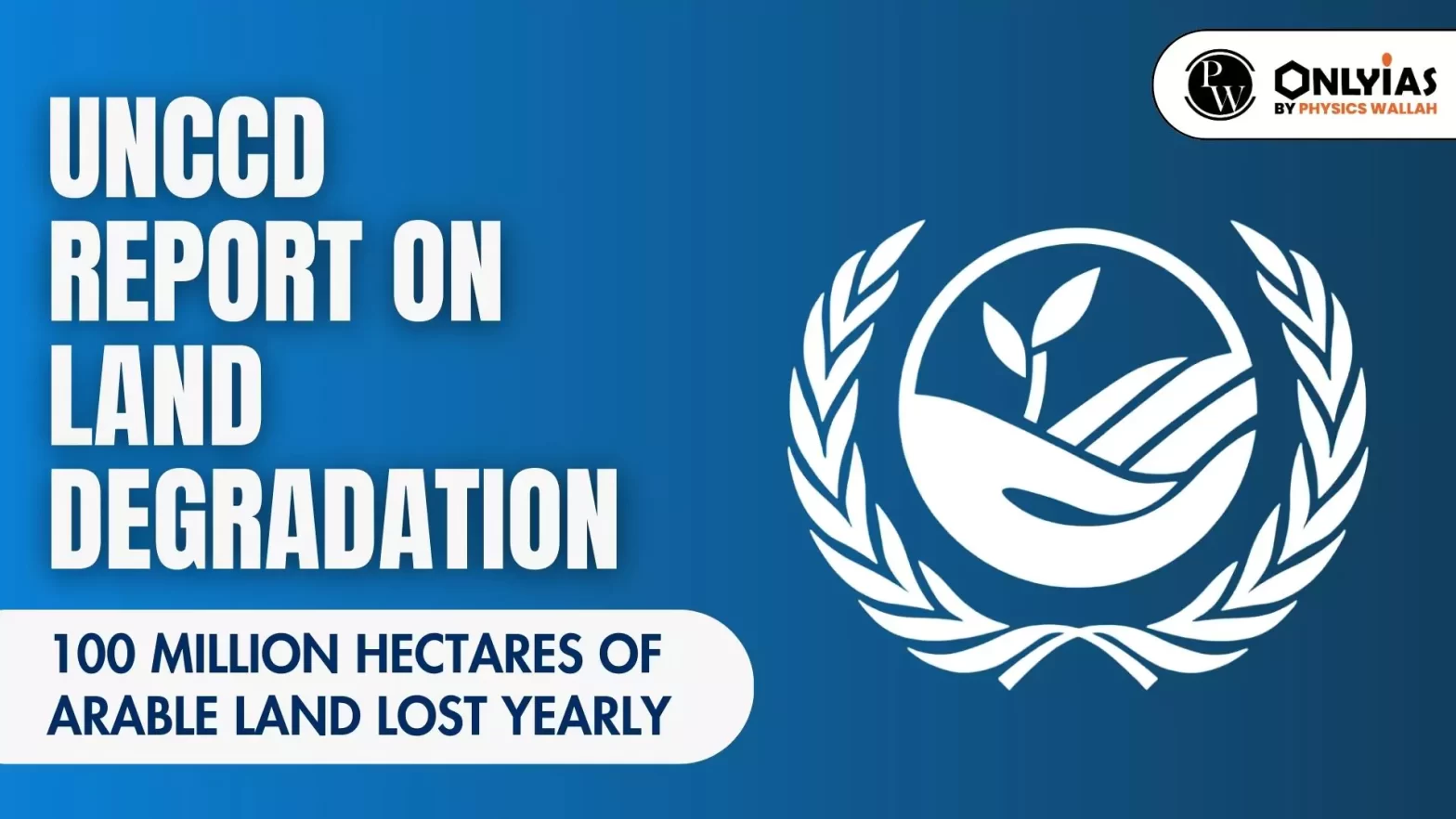Context:
- This article is based on the news “100 million hectares of arable land lost yearly to degradation, shows UN report” Which was published in the DownToEarth. The UN Convention to Combat Desertification (UNCCD) has launched its first-ever Data Dashboard, aggregating national reporting figures from 126 countries.
- The data indicates that land degradation is rapidly increasing in severity across all regions, underscoring the pressing need for global action.
| Relevancy for Prelims: United Nations, UNCCD Report on Land-Degradation, Land Desertification, Soil Erosion, Land Degradation Neutrality (LDN), and Pradhan Mantri Krishi Sinchayee Yojana.
Relevancy for Mains: Key findings of UNCCD on land degradation, Causes and impacts of land-degradation, and measures taken by the Government to prevent land-degradation. |
What are the key findings of UNCCD on land degradation?
- Extent of Land Degradation: Between 2015 and 2019, the world lost at least 100 million hectares of healthy and productive land each year, which is twice the size of Greenland.
- Regional Disparities: Eastern and Central Asia, as well as Latin America and the Caribbean, witness the most severe land degradation, impacting over 20% of their total land area.
- Faster Degradation: Sub-Saharan Africa, Western and Southern Asia, Latin America and the Caribbean experience land-degradation at rates exceeding the global average.
- Notable Loss: Sub-Saharan Africa, Latin America and the Caribbean have lost 163 million and 108 million hectares, respectively, to land degradation since 2015.
- Land Restoration “Bright spots”:
- Botswana: Reduced land degradation from 36% to 17% of its territory. Committed 45.3 million hectares to land-degradation neutrality and reported 1.42 million hectares as “bright spot” areas.
- Dominican Republic: Decreased degraded land from 49% to 31% between 2015 and 2019. Ongoing efforts to restore 240,000 hectares.
- Uzbekistan: Reported the highest proportion of degraded land (26.1%) in Central Asia but reduced it from 30% to 26% compared to 2015. Conducted saxaul planting on 1.6 million hectares to combat the drying of the Aral Sea.
- Land Degradation Neutrality (LDN) Goal Achievability: To achieve Sustainable Development Goals, the world must restore 1.5 billion hectares of degraded land by 2030 if current land-degradation trends continue.
- Sustainable Development Goal 15: Life on Land calls for protecting, restoring, and sustaining land-based ecosystems.
- In doing so target 15.3 specifically aims to achieve a land degradation-neutral world by 2030.

What is the United Nations Convention to Combat Desertification (UNCCD)?
- The UNCCD is one of three Conventions from the 1992 Earth Summit in Rio de Janeiro.
- Established in 1994
- It is the sole legally binding international agreement linking environment and development to sustainable land management.
- Members: 197 parties, India became a signatory in 1994 and ratified it in 1996.
- UNCCD’s Objectives:
- Aims to improve living conditions in drylands.
- Seeks to maintain and restore land and soil productivity.
- Mitigates the effects of drought.
Land Degradation Neutrality (LDN)- UNCCD
- Land Degradation Neutrality (LDN) is a state where land resources needed for ecosystems and food security remain stable or improve over time.
- A key part of this strategy is to restore one billion hectares of land by 2030 with proper funding and action.
- Promisingly, 109 countries have set voluntary LDN targets for 2030.
- Between 2016 and 2019, approximately $5 billion from bilateral and multilateral sources has been allocated to combat desertification, land-degradation, and drought, supporting projects in 124 nations.
Land Degradation Neutrality (LDN) Objectives
- Maintaining or improving the sustainable delivery of ecosystem services
- Maintaining or improving land productivity to enhance global food security
- Increasing the resilience of land and the populations dependent on it
- Seeking synergies with other social, economic, and environmental objectives
- Reinforcing and promoting responsible and inclusive land governance
|
What is land degradation?
- Land degradation results from human-induced actions that exploit land, causing its utility, biodiversity, soil fertility, and overall health to decline.
- Land-degradation is caused by multiple forces, including extreme weather conditions, particularly drought.
- Desertification is a form of land-degradation by which fertile land becomes desert.
- Land-degradation within dry land regions (arid, semi-arid and dry sub-humid regions) is termed as ‘desertification’.
- Status of Land degradation in India (refer to Image).

What are the causes of land degradation?
- Natural Cause:
- Loss of Soil Cover: Soil erosion significantly contributes to land degradation in the country, primarily due to rainfall and surface runoff. This factor was responsible for 11.01% of desertification in the country.
- Water Erosion: Water erosion contributed to 10.98% of desertification in India during 2011-13.
- Wind Erosion: Wind erosion, where the wind carries away soil, accounted for 5.46% of desertification in India.
- Anthropogenic Causes:
- Poor Agricultural Practices: Land degradation in India is exacerbated by poor agricultural practices, including improper crop rotations and the overuse of agrochemicals.
- Deforestation: Activities such as deforestation and shifting cultivation contribute to the degradation of vegetation, which is essential for maintaining soil health.
- The degradation of vegetation was found to be responsible for 9.15% of desertification in the country.
- Increasing Urbanization: The increasing population pressure in India has led to higher urbanization rates. This has resulted in the diversion of land from agriculture to urban development.
- Overgrazing: India has one of the largest cattle populations in the world. However, unsustainable grazing practices contribute to land degradation.
- Climate Change: Climate change intensifies desertification as rising temperatures and frequent droughts become prominent. Forest fires, a consequence of this, devastate forests and contribute to desertification.

What are the impacts of land degradtion?
- Economic Impact: Land degradation resulted in the country losing more than 2% of the GDP for 2014-15, as per the Energy and Resources Institute (TERI).
- Environmental Impact
- Soil Erosion: The process by which topsoil is detached from land and carried away by water, ice, sea waves, or wind.
- Loss of Fertility: Resulting from the use of scientific inputs like irrigation, fertilizers, and pesticides, as well as unscientific cropping practices.
- Salinity/Alkalinity: Occurs in areas with temporary water surplus and high temperatures due to over-irrigation or excessive rainfall, affecting soil fertility.
- Water Scarcity: The dryland population vulnerable to water stress and increased drought intensity is projected to reach 178 million under ideal conditions of 1.5 degrees Celsius warming by 2050.
- Potential Impacts on Human Health
- Reduced food and water supplies can lead to higher threats of malnutrition.
- Increased risk of water- and food-borne diseases due to poor hygiene and a lack of clean water.
- Respiratory diseases can result from atmospheric dust caused by wind erosion and air pollutants.
- The spread of infectious diseases may occur as populations migrate, impacting public health.
- Rights of Indigenous People: Insecure land tenure affects the ability of people and communities, including indigenous groups, to combat climate change. Land degradation further endangers their rights and livelihoods.
Also read: World Food Day: Date, Theme, Significance and Solution
What are the measures taken by the Government to prevent land degradation?
- Desertification and Land-Degradation Atlas
- Published by Space Applications Centre (SAC) of the Indian Space Research Organisation.
- Provides data on the extent of land-degradation and desertification in India.
- Estimated land degradation and desertification in India: 97.84 million hectares in 2018-19. Offers state-wise information on degraded land to aid restoration planning.
- Online Portal for Visualization
- Developed in collaboration with Space Application Center (SAC), Ahmedabad.
- Allows visualization of degraded land areas and the processes causing degradation.
- Centre of Excellence at ICFRE Dehradun
- Envisioned at the Indian Council for Forestry Research and Education (ICFRE), Dehradun.
- Focuses on South-South Cooperation for knowledge sharing and best practices.
- Aims to share India’s experiences in sustainable land management.
- Supports transformative projects, capacity building, and program development.
Global Efforts
- The Bonn Challenge:
- Aims to restore 150 million hectares of deforested and degraded land by 2020 and 350 million hectares by 2030.
- Great Green Wall:
- Initiated by the Global Environment Facility (GEF).
- Eleven countries in Sahel-Saharan Africa are working to combat land-degradation and restore native plant life to the landscape.
|
Way forward
- Integrated Land Use Planning: Implementing integrated land use planning is vital. This approach involves identifying optimal land use combinations to meet the needs of stakeholders while preserving land resources.
- Identifying Global Restoration Hotspots: A cost-effective strategy involves pinpointing global restoration hotspots within landscapes to maximize benefits and focus restoration efforts efficiently.
- Regenerative Agricultural Practices: Promoting regenerative agricultural practices, such as terrace farming and rainwater harvesting, plays a crucial role in land restoration.
- These practices not only restore land but also have the potential to increase crop yields, reduce greenhouse gas emissions, and sequester atmospheric carbon.
- Convergence with the MGNREGS and PMKSY: The government is now planning to bring convergence between the Mahatma Gandhi National Rural Employment Guarantee Scheme (MGNREGS) and the Pradhan Mantri Krishi Sinchayee Yojana (PMKSY).
- It could help treat about 30% more land than feasible with the current scheme size.
- China Experience:
- Great Green Wall (Three-North Shelterbelt Program): China has been implementing this afforestation program since the late 1970s. It involves planting large-scale monoculture forest strips of non-native species to combat desertification and dust storms in the Gobi Desert region.
Also read: Climate Smart Agriculture (CSA)
Conclusion:
UNCCD data reveals alarming global trends, with 100 million hectares of arable land lost annually due to land degradation, underscoring the urgent need for collaborative international efforts to address and reverse this concerning phenomenon.
| Prelims Question (2016)
What is/are the importance/ importances of the ‘United Convention to Combat Desertification (UNCCD)’?
1. It aims to promote effective action through innovative national programmes and supportive international partnerships
2. It has a special/particular focus on South Asia and North Africa regions, and its Secretariat facilitates the allocation of major portion of financial resources to these regions.
3. It is committed to bottom-up approach, encouraging the participation of local people in combating the desertification.
Select the correct answer using the code given below.
(a) 1 only
(b) 2 and 3 only
(c) 1 and 3 only
(d) 1, 2 and 3
Ans: (c) |
To get PDF version, Please click on "Print PDF" button.




